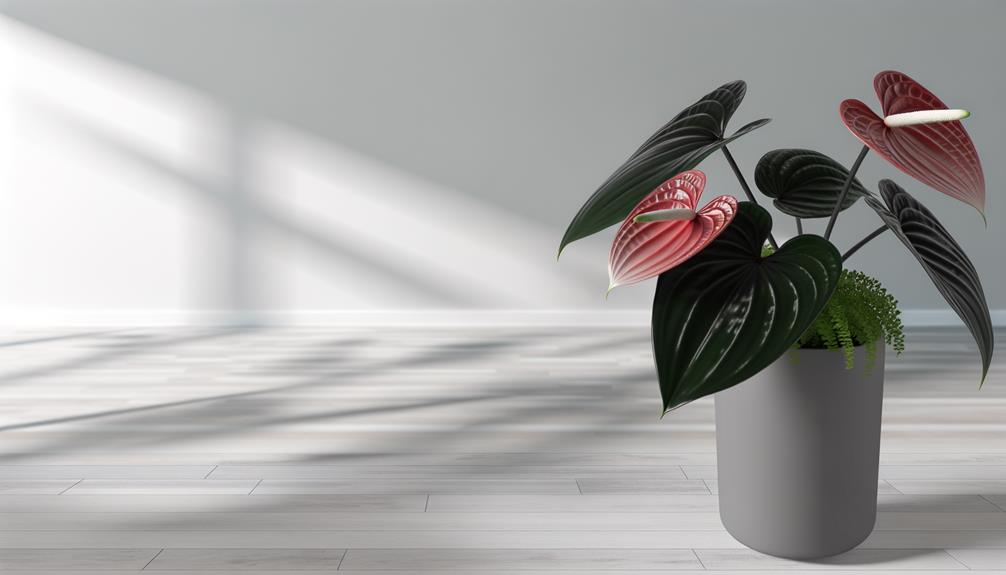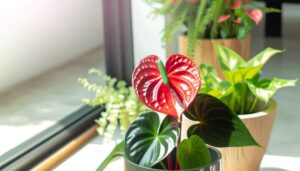Caring for Anthurium Black Dragon
To care for your Anthurium Black Dragon, provide bright, indirect sunlight with a light intensity of 10,000-20,000 lumens. Maintain humidity levels between 60%-80% and guarantee good air circulation.
Water when the top 2 inches of soil are dry, using distilled or rainwater, and avoid drafts. Use a peat moss, pine bark, and perlite soil mix with a slightly acidic pH.
Fertilize every 4-6 weeks during the growing season with a balanced liquid fertilizer. Regularly monitor leaf color and soil moisture, and prune dead leaves.
Elevate the pot for better drainage, and ensure consistent watering practices for healthy growth. Explore more to master the nuances.

Key Takeaways
- Provide bright, indirect sunlight with 10,000 to 20,000 lumens.
- Water with distilled or rainwater when the top 2 inches of soil are dry.
- Maintain humidity between 60% and 80% for optimal growth.
- Use a soil mix of peat moss, pine bark, and perlite, and repot every two years.
- Apply balanced liquid fertilizer every 4-6 weeks during the growing season.
Light Requirements
Anthurium Black Dragon thrives in bright, indirect sunlight, which mimics its natural tropical understory environment. You'll need to place it where it can receive filtered sunshine, ideally avoiding direct exposure that could scorch the leaves.
Aim for a light intensity of 10,000 to 20,000 lumens, measured with a light meter for accuracy. If natural light is inadequate, consider supplementing with full-spectrum LED grow lights, positioned about 12 inches above the plant. Remember, the plant's photosynthetic efficiency depends on this prime light range.
Monitor leaf color and growth rate; pale or yellowing leaves indicate excessive light, while dark, leggy growth suggests insufficient light. By maintaining these specific conditions, you'll optimize your Anthurium Black Dragon's vibrancy and health.
Watering Schedule
Just as essential as light, maintaining a consistent watering schedule is important for the health of your Anthurium Black Dragon. You'll want to water when the top 2 inches of soil feel dry to the touch.
Use distilled or rainwater to avoid mineral buildup; tap water often contains salts that can harm the plant. Aim for a balance—overwatering can lead to root rot, while underwatering causes dehydration.
During the active growing season, typically spring through early fall, increase watering frequency. In contrast, reduce it during the plant's dormancy in winter. Consistently monitor the soil moisture level using a hygrometer for precision.
Ideal Soil Mix
To maximize growth for your Anthurium Black Dragon, use a soil mix composed of equal parts peat moss, pine bark, and perlite. This composition provides the necessary balance of nutrients, moisture retention, and pH level.
Additionally, the mix promotes proper drainage and aeration, preventing root rot and supporting healthy root systems.
Soil Composition Essentials
Achieving the best soil composition for Anthurium Black Dragon necessitates a well-draining blend that combines equal portions of orchid bark, perlite, and peat moss to secure proper aeration and moisture retention. Begin by selecting high-quality orchid bark, which encourages root aeration and prevents compaction.
Incorporate perlite to improve drainage and sustain soil structure. Peat moss is crucial for its water retention capabilities and slight acidity, fostering nutrient uptake. Blend these components thoroughly to guarantee uniformity.
Avoid dense soils, as they can suffocate roots and lead to root rot. Maintain a slightly acidic pH level, around 5.5 to 6.5, to optimize nutrient availability. By carefully selecting and mixing these elements, you'll establish the ideal environment for your Anthurium Black Dragon's roots.
Drainage and Aeration
Effective drainage and aeration are necessary for the health of Anthurium Black Dragon, as they prevent waterlogging and guarantee roots receive sufficient oxygen.
You'll need a soil mix composed of one part orchid bark, one part perlite, and one part peat moss. Orchid bark ensures ample air pockets, facilitating root respiration. Perlite enhances soil drainage, preventing root rot. Peat moss retains moisture while maintaining a slightly acidic pH, ideal for Anthuriums.
Using a pot with drainage holes is essential; it allows excess water to escape, reducing the risk of waterlogged roots.
Repot your Anthurium every two years, revitalizing the soil mix to maintain optimal drainage and aeration.
With this mix, your Anthurium Black Dragon will flourish.
Humidity Needs
Anthurium Black Dragon thrives in environments where the relative humidity consistently ranges between 60% and 80%. You'll need to monitor ambient moisture levels diligently, as insufficient humidity can lead to desiccation of the leaves and impaired physiological functions. Use a hygrometer to ensure accurate readings.
Consider deploying a humidifier in drier seasons or climates. Alternatively, place a water-filled tray with pebbles beneath the plant's container to facilitate evaporative cooling, enhancing local humidity. Misting the foliage periodically with distilled water will replicate its native tropical conditions, but avoid over-saturation to prevent fungal growth.
Ensure air circulation remains optimal, as stagnant air can exacerbate humidity imbalances and promote pathogenic infestations. This careful attention will safeguard your Anthurium's lush vigor.
Fertilizing Tips
Proper humidity management sets the stage for best nutrient uptake, making a well-balanced fertilization regimen essential for your Anthurium Black Dragon's sustained growth and vibrant foliage. Use a liquid fertilizer with a balanced N-P-K ratio, such as 20-20-20, diluted to half strength. Apply this every 4-6 weeks during the growing season.
Verify micronutrients like magnesium, calcium, iron, and zinc are included to prevent deficiencies. Avoid over-fertilizing, as this can cause root burn and leaf yellowing. Monitor the pH level of your soil, keeping it slightly acidic (5.5-6.5) to optimize nutrient absorption.
Regularly flush the substrate with water to prevent salt buildup. This meticulous care guarantees your Anthurium Black Dragon thrives, showcasing its stunning, dark-hued leaves.
Common Issues
When caring for your Anthurium Black Dragon, you'll encounter common issues like leaf discoloration, which often indicates nutrient deficiencies or improper light exposure.
Watch for signs of pest infestations such as aphids and spider mites, which can cause damage to foliage.
Monitor for overwatering symptoms, including root rot and yellowing leaves, to maintain the best plant health.
Leaf Discoloration Causes
Leaf discoloration in Anthurium Black Dragon often results from nutrient deficiencies, improper watering practices, or pest infestations. You should monitor the foliage closely.
Chlorosis, where leaves turn yellow, may indicate nitrogen or iron deficiency. Maintain a balanced fertilization with macro and micronutrients.
Overwatering can cause root rot, leading to browning leaf tips and edges. Always check soil moisture before watering and use well-draining potting mix. Additionally, ensure that waterlogged conditions are avoided to prevent anaerobic root environments.
Dark, necrotic spots might signify overexposure to direct sunlight or low humidity levels. Sustain optimal humidity around 60-80% and place your plant in bright, indirect light.
Pest Infestation Signs
In addition to managing nutrient deficiencies and watering practices, you must also stay vigilant for signs of pest infestations that commonly afflict Anthurium Black Dragon. Look out for symptoms such as distorted leaves, discolored patches, and the presence of honeydew. Aphids, spider mites, and mealybugs are frequent culprits. Here's a quick reference table to help you identify these pests and their symptoms:
| Pest | Symptoms | Recommended Action |
|---|---|---|
| Aphids | Distorted, yellowing leaves | Apply insecticidal soap |
| Spider Mites | Fine webbing, stippled leaves | Increase humidity, use miticide |
| Mealybugs | Cotton-like masses, honeydew | Dab with alcohol, use neem oil |
Regular inspection and timely treatment will guarantee your Anthurium Black Dragon remains healthy and thriving.
Overwatering Symptoms
Overwatering your Anthurium Black Dragon often results in root rot, chlorosis, and edema, compromising the plant's overall health. Root rot manifests as brown, mushy roots, impeding water and nutrient uptake.
Chlorosis, or yellowing of leaves, occurs due to impaired chlorophyll synthesis. Edema, evident as water-soaked blisters on leaves, arises from cellular water imbalance.
You'll notice a musty odor from decaying roots, signaling anaerobic bacterial activity. Check soil moisture levels regularly; the top inch should dry out before re-watering. Ensure ample drainage by using a well-aerated, chunky potting mix.
Elevate the pot to prevent water stagnation. By carefully managing watering practices, you'll maintain your Anthurium Black Dragon's essentiality and lush appearance.
Conclusion
So, you've mastered the light, watering, and soil needs of your Anthurium Black Dragon.
Ironically, despite its 'black dragon' name, it's not a fire-breathing beast but a humidity-loving plant.
You've even nailed the fertilizing schedule!
Funny how something that sounds so fierce just needs a bit of TLC, isn't it?
Now, with these scientific insights and precise care steps, you're well-equipped to keep this tropical beauty thriving—no dragon-slaying required.






